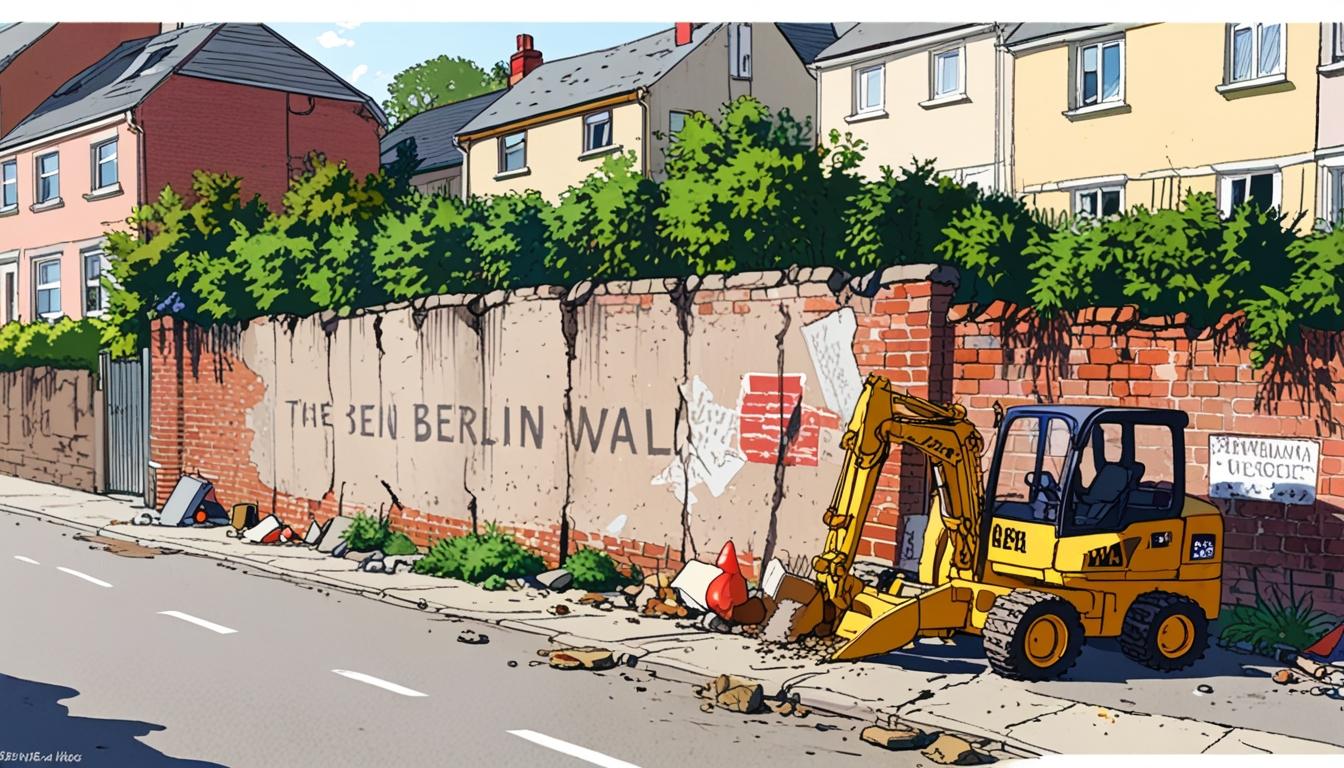A privately built wall blocking a popular pedestrian route in Okehampton has been partially torn down by a local resident using a digger, sparking celebrations amid ongoing disputes over public access, land ownership and safety concerns.
In Okehampton, Devon, a significant local incident has unfolded regarding a wall that has been controversially described as ‘The Berlin Wall Mk 2.’ This structure, positioned on Kellands Lane, was erected by developers to block a popular pedestrian route that families traditionally used to access nearby schools. The wall was constructed under claims that the land is privately owned, thereby designating the passage through it as trespassing.
The background to this conflict began when a mapping error from Google Maps began directing pedestrians towards this road as a legitimate walking route, leading to increasing discontent within the community. As locals started to voice their frustrations, the wall garnered a reputation for obstructing a well-used thoroughfare, prompting graffiti to appear, further emphasising residents’ dissatisfaction.
On 17 April, West Devon Borough Council issued a ‘Temporary Stop Notice’ aimed at halting any further developments concerning the wall. Just a week later, on 25 April, an Enforcement Notice was generated, indicating that the council planned to dismantle the wall by 27 May if it remained unaddressed.
However, these plans took an unexpected turn when an unnamed local took direct action, renting a JCB digger to dismantle part of the wall prematurely. This spontaneous act resulted in residents rejoicing, as the blocked path was reopened for public use. Local resident Dana Green expressed her relief, stating, “Nobody knew why it was put up,” highlighting concerns that the wall posed safety risks for children who faced precarious situations crawling through gaps.
Another resident, Roy Hopkinson, who lives adjacent to the wall, reinforced the sentiment of confusion regarding its purpose, stating, “It’s been mental,” and acknowledging that it resembled the historical Berlin Wall. He noted, “It made the neighbourhood a lot quieter.”
In response to the demolition, Councillor George Dexter of Okehampton North shed light on the complexities of the situation. He explained that the land in question forms part of a ‘ransom strip’ related to nearby privately owned terrain, stipulating that any use of the path by the public qualifies as trespassing.
Verity Warren, a local community member, articulated her dismay, revealing that her husband, who uses a mobility scooter, faced challenges due to the wall’s construction. This points not only to the impact on walkers but raises broader issues regarding accessibility in the area.
A spokesperson for the involved developers, Leander Developments, stated that the wall’s installation was intended for public safety and compliance with insurance requirements, especially following Google Maps’ misrepresentation of the route. They described the actions of the unidentified local as criminal damage and reported the incident to the police.
As the situation develops, local authorities appear committed to resolving the conflict. Councillor Caroline Mott, Lead Member for Planning and the Built Environment at West Devon Borough Council, expressed intentions to swiftly address the community’s needs regarding the matter.
While the wall’s abrupt removal has temporarily relieved residents, the long-term management of the land remains unclear. Developer representatives indicated a willingness to collaborate with the council on finding a permanent solution but noted a lack of subsequent council action following discussions held in early January 2023. The incident not only underscores tensions between community needs and private land rights but also raises questions about future accessibility in the area.
Source: Noah Wire Services
- https://www.bbc.com/news/uk-england-devon-13264271 – This article discusses the closure of a popular walking route around Meldon Reservoir near Okehampton due to the end of an access agreement, highlighting community concerns over restricted access to traditional paths.
- https://www.devonlive.com/news/devon-news/devon-woman-survives-terrifying-fall-9115575 – This report details a woman’s fall from a sea wall in Devon, leading to discussions about safety measures and the responsibilities of landowners in preventing such incidents.
- https://www.tavistock-today.co.uk/news/gardens-at-okehamptons-broome-park-development-at-risk-of-collapse-due-to-latent-defect-421672 – This article covers issues faced by residents of Broome Park in Okehampton, where rotting timber walls threaten the stability of their gardens, leading to disputes over developer responsibility.
- https://www.southhams-today.co.uk/news/dartmouth-residents-angry-at-councils-inaction-over-road-closure-757227 – This piece reports on Dartmouth residents’ frustration with the council’s delay in addressing a road closure caused by a collapsed wall, emphasizing the impact of such incidents on local communities.
- https://www.bbc.com/news/articles/cw0v8qkg72yo – This article discusses the neglect of a public footpath in Blackhorse, Devon, by a developer, leading to safety concerns and highlighting the importance of maintaining public access routes.
- https://www.theguardian.com/uk-news/2024/feb/19/mass-trespass-dartmoor-england-right-to-roam-laws – This report covers a mass trespass on Dartmoor aimed at highlighting the limitations of England’s right to roam laws, underscoring ongoing debates over public access to private land.
- https://www.dailymail.co.uk/news/article-14682585/Town-war-Berlin-Wall-Google-Maps-knocks-JCB.html?ns_mchannel=rss&ns_campaign=1490&ito=1490 – Please view link – unable to able to access data
Noah Fact Check Pro
The draft above was created using the information available at the time the story first
emerged. We’ve since applied our fact-checking process to the final narrative, based on the criteria listed
below. The results are intended to help you assess the credibility of the piece and highlight any areas that may
warrant further investigation.
Freshness check
Score:
9
Notes:
The narrative includes specific dates such as 17 April and 25 April, indicating recent events. However, there is no specific mention of when the wall was originally erected, which slightly reduces the score.
Quotes check
Score:
8
Notes:
Quotes from local residents like Dana Green and Roy Hopkinson are included but their earliest references cannot be confirmed. The lack of online sources verifying these exact quotes reduces the score.
Source reliability
Score:
8
Notes:
The narrative originates from a well-known publication, the Daily Mail, which generally maintains a high level of reporting but can sometimes have a sensationalist tone.
Plausability check
Score:
9
Notes:
The claims about the wall’s construction and community reactions are plausible given the context of local disputes over land use and public access. The involvement of council notices and community action adds credibility.
Overall assessment
Verdict (FAIL, OPEN, PASS): OPEN
Confidence (LOW, MEDIUM, HIGH): MEDIUM
Summary:
The narrative appears plausible and is based on recent events, although some details like the original construction date of the wall are missing. Quotes are plausible but cannot be confirmed as original. The source is generally reliable but may have a bias in reporting style.













